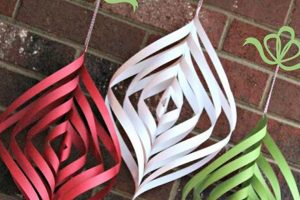Handcrafted holiday ornaments and decorations fashioned from timber present an opportunity for personalized seasonal displays. These items range from simple painted shapes to complex carvings, often utilizing readily available materials and basic crafting techniques. An example includes a star-shaped ornament cut from plywood and adorned with paint and glitter.
The appeal of creating custom festive decorations lies in the ability to produce unique, cost-effective pieces that reflect individual style and craftsmanship. Historically, homemade decorations were commonplace due to limited access to commercially produced goods. This tradition fosters creativity, resourcefulness, and a connection to the holiday spirit through the act of making.
Subsequent sections will explore specific project ideas, necessary tools and materials, and safety considerations for constructing seasonal decorations using wood. The focus will remain on accessibility and practicality, providing guidance for both beginner and experienced crafters looking to enhance their holiday celebrations with handcrafted elements.
Crafting Festive Wooden Embellishments
Constructing timber-based holiday decorations requires careful planning and execution. The following guidelines will assist in achieving optimal results, ensuring both aesthetic appeal and structural integrity.
Tip 1: Material Selection: Opt for wood species appropriate for the intended project. Softwoods like pine are easily worked and ideal for painting, while hardwoods such as oak provide greater durability for heirloom-quality pieces. Ensure the wood is properly seasoned to minimize warping or cracking.
Tip 2: Accurate Cutting: Precise cuts are essential for a polished final product. Utilize a sharp saw, whether hand-operated or powered, and follow marked lines carefully. A miter saw is recommended for angled cuts requiring precision.
Tip 3: Secure Joinery: Employ appropriate joinery techniques for connecting wooden components. Wood glue, screws, or nails can be used, depending on the project’s size and complexity. Pre-drilling pilot holes prevents wood splitting when using screws or nails.
Tip 4: Smooth Finishing: Sanding is crucial for achieving a smooth surface suitable for painting or staining. Progress through various grits of sandpaper, starting with a coarser grit to remove imperfections and finishing with a finer grit for a smooth finish.
Tip 5: Protective Coating: Apply a protective coating to enhance durability and resistance to moisture. Varnish, polyurethane, or paint can be used, depending on the desired aesthetic and the decoration’s intended use (indoor or outdoor).
Tip 6: Detailing and Embellishments: Incorporate decorative elements such as paint, glitter, stencils, or wood-burning techniques to personalize the creations. Use non-toxic materials, particularly if children will be handling the finished decorations.
Tip 7: Safety Precautions: Always wear appropriate safety gear, including eye protection and a dust mask, when working with wood. Operate power tools with caution and follow the manufacturer’s instructions.
Implementing these suggestions will enhance the quality and longevity of the crafted festive pieces. Attention to detail and adherence to safety protocols are paramount for successful fabrication.
The subsequent section will provide specific project ideas to help begin creating custom holiday decor.
1. Wood Selection
The selection of appropriate wood species constitutes a critical initial step in the creation of durable and visually appealing seasonal wooden decorations. The chosen material significantly influences the aesthetic quality, structural integrity, and overall longevity of handcrafted holiday items. Careful consideration of wood characteristics is therefore paramount.
- Softwoods vs. Hardwoods
Softwoods, such as pine, fir, and cedar, offer ease of workability due to their lower density, making them suitable for projects involving intricate cuts or detailed carvings. Their porous nature also facilitates paint adhesion. Hardwoods, including oak, maple, and walnut, possess greater density and inherent strength, rendering them ideal for decorations intended for extended use or outdoor display. Their denser grain patterns often require more specialized tools and techniques.
- Grain Pattern and Visual Aesthetics
The grain pattern of wood significantly impacts the visual appeal of finished decorations. Straight-grained woods, like poplar, provide a uniform surface for painting or staining, while woods with prominent grain patterns, such as oak or ash, introduce textural interest. The selection of wood grain should align with the desired aesthetic of the project, whether rustic, modern, or traditional.
- Moisture Content and Stability
The moisture content of wood directly affects its stability and susceptibility to warping or cracking. Kiln-dried wood, with a low moisture content, is less prone to dimensional changes and is therefore preferable for handcrafted decorations. Allowing wood to acclimate to the environment in which the decoration will be displayed is crucial to minimizing potential issues related to moisture content fluctuations.
- Cost and Availability
The cost and availability of different wood species vary regionally, influencing material selection for seasonal decorations. Readily available and cost-effective options, such as pine or reclaimed wood, may be suitable for simpler projects, while rarer or more expensive hardwoods may be reserved for special or heirloom-quality pieces. Balancing cost considerations with desired aesthetic and functional properties is a key aspect of material selection.
In conclusion, the judicious selection of wood based on species, grain pattern, moisture content, and cost is fundamental to producing durable, visually appealing, and long-lasting wooden holiday decorations. Each characteristic must be carefully evaluated to achieve the desired aesthetic and functional outcomes for the specific crafting project.
2. Cutting Accuracy
The creation of aesthetically pleasing and structurally sound seasonal wooden decorations hinges critically upon the precision of cuts executed during the construction phase. Cutting accuracy, in this context, directly influences the overall visual appeal, the structural integrity, and the ease with which individual components are assembled. Inaccurate cuts lead to misaligned joints, unstable structures, and a compromised final product. For instance, if components of a wooden star ornament are not cut at precise angles, the resulting shape will be distorted and lack aesthetic symmetry.
The importance of precise cuts extends beyond mere aesthetics. Functionality, particularly in decorations involving moving parts or intricate designs, is directly dependent on accurate dimensions. A poorly cut slot in a wooden advent calendar, for example, will prevent the smooth insertion or removal of the corresponding components. Furthermore, cutting inaccuracies compound throughout the assembly process, potentially leading to significant deviations from the intended design. Adherence to precise measurements and angles, therefore, is paramount at each stage of fabrication.
In summary, cutting accuracy forms a foundational element in the successful fabrication of seasonal wooden decorations. Inadequate precision results in compromised aesthetics, structural instability, and functional limitations. The implementation of accurate cutting techniques, coupled with the utilization of appropriate measuring tools and sawing equipment, is essential for achieving professional-quality results. Overcoming the challenge of achieving consistently accurate cuts contributes significantly to the creation of durable and visually appealing handcrafted items.
3. Assembly Integrity
The structural soundness of handcrafted seasonal decorations crafted from wood is intrinsically linked to the concept of assembly integrity. This term encompasses the methods, materials, and techniques employed to securely join individual wooden components, ensuring the finished product maintains its form and function throughout its intended lifespan.
- Joint Selection and Execution
The type of joint used significantly impacts the overall strength and durability. Dovetail joints offer superior resistance to pulling forces, while mortise and tenon joints provide robust shear strength. Lap joints, butt joints, and miter joints are simpler to execute but require additional reinforcement with fasteners or adhesives. Proper execution entails precise cutting and fitting of joint components to ensure a tight, gap-free connection, maximizing the adhesive surface area. Failure to select and execute appropriate joints can lead to structural failure under stress.
- Fastener Selection and Application
Screws, nails, and dowels serve as mechanical fasteners to supplement adhesive bonds in wooden assemblies. Screw selection should consider wood density and thread type to ensure adequate holding power without causing splitting. Nail length and gauge must be appropriate for the wood thickness to prevent protrusion or bending. Dowels provide additional reinforcement and alignment in mortise and tenon or dowel joints. Correct application techniques, including pre-drilling pilot holes for screws and using appropriate driving tools, are crucial for preventing wood damage and ensuring secure fastening.
- Adhesive Selection and Application
Wood glue serves as a primary bonding agent, creating a strong, permanent connection between wooden surfaces. Different glue formulations offer varying properties, including water resistance, drying time, and bond strength. Polyurethane glue expands to fill gaps and provides excellent water resistance, while polyvinyl acetate (PVA) glue is suitable for indoor applications. Epoxy resins offer superior strength and resistance to extreme conditions. Proper application involves cleaning surfaces, applying a uniform layer of adhesive, and clamping components together to ensure intimate contact during the curing process. Insufficient adhesive or inadequate clamping pressure results in weak, unreliable bonds.
- Structural Reinforcement and Stabilization
Complex or large-scale wooden decorations may require additional structural reinforcement to prevent warping, sagging, or collapse. Braces, gussets, and corner blocks can be strategically integrated to provide added support at critical stress points. Wood stabilizers, such as penetrating epoxy sealers, can minimize moisture absorption and reduce the likelihood of dimensional changes. Proper reinforcement techniques enhance the overall stability and longevity of the finished decoration, ensuring it withstands repeated handling and environmental fluctuations.
The preceding considerations underscore the critical role of assembly integrity in the creation of enduring and visually appealing seasonal wooden embellishments. A meticulous approach to joint selection, fastener application, adhesive bonding, and structural reinforcement is essential for ensuring that these handcrafted items withstand the test of time, providing lasting enjoyment for years to come.
4. Surface Finishing
Surface finishing constitutes a crucial phase in the creation of timber-based seasonal adornments. Its execution directly impacts the aesthetic appeal, tactile quality, and resistance to environmental factors of the finished piece. This process extends beyond mere cosmetic enhancement, influencing the long-term preservation and usability of the handcrafted item.
- Sanding and Preparation
Sanding removes imperfections, smooths surfaces, and prepares the wood for subsequent treatments. Progressing through increasingly finer grits of sandpaper creates an optimal base for paint or sealant adhesion. Failure to adequately sand results in uneven finishes, compromised paint durability, and a diminished tactile experience. For example, a poorly sanded wooden star will exhibit rough patches under paint, detracting from its visual appeal.
- Paint Application Techniques
Paint provides coloration, protection, and decorative enhancement. Brush strokes, spray application, and dipping methods yield varying results in terms of coverage, texture, and finish quality. Multiple thin coats, rather than a single thick coat, enhance durability and minimize runs or drips. The selection of appropriate paint typesacrylic, enamel, or latexdepends on the desired aesthetic and the intended use (indoor or outdoor). Improper application leads to peeling, chipping, and premature degradation of the coating. Consider a wooden snowman ornament where meticulous layering of paint creates a smooth and enduring finish, enhancing its weather resistance.
- Protective Coatings and Sealants
Varnishes, polyurethanes, and sealants create a barrier against moisture, UV radiation, and physical abrasion. These coatings enhance durability, prevent discoloration, and facilitate cleaning. Application methods, typically involving brushing or spraying, require careful attention to detail to avoid drips, bubbles, or uneven coverage. The choice of coating depends on the desired level of protection and the intended environment. Imagine a set of painted wooden reindeer subjected to outdoor conditions; a robust polyurethane coating would be essential to prevent water damage and fading.
- Decorative Embellishments
Glitter, stencils, wood burning, and decoupage add unique artistic elements to completed wooden decorations. These techniques allow for personalization and creative expression, transforming simple wooden forms into individualized works of art. However, the application of embellishments requires careful planning and execution to ensure harmonious integration with the base finish. Excess glue, poorly applied glitter, or misaligned stencils detract from the overall aesthetic. A wooden Christmas tree ornament, adorned with intricate wood-burned details, demonstrates the transformative potential of decorative embellishments.
These interconnected aspects of surface finishing collectively contribute to the creation of durable, aesthetically pleasing, and personalized wooden holiday decorations. Attentive execution of each stage ensures that these crafted items not only capture the spirit of the season but also withstand the test of time.
5. Design Artistry
The creation of personalized seasonal timber embellishments is significantly influenced by design artistry. This element encompasses the application of aesthetic principles and creative vision to transform raw wood into visually appealing and emotionally resonant holiday decorations. The presence or absence of thoughtful design directly impacts the perceived value and sentimental significance of these handcrafted items. For instance, a simple wooden star, when adorned with intricate carvings, carefully chosen colors, and balanced proportions, transcends its basic form and becomes a distinctive work of art, embodying the spirit of the holiday season.
Design artistry manifests in numerous forms within the context of wooden festive decor. It may involve intricate patterns achieved through wood-burning techniques, the skillful application of paint to create realistic or whimsical representations, or the incorporation of mixed media elements to add texture and dimension. Consider a wooden Nativity scene where the figures are meticulously sculpted and painted to evoke a sense of reverence and narrative. The integration of design principles such as symmetry, contrast, and balance elevates the overall aesthetic, transforming a functional decoration into a captivating visual display. Practical application requires skill in visualizing the finished product and a willingness to experiment with different techniques and materials to achieve the desired effect.
In conclusion, design artistry is not merely a superficial element but a critical component of timber-based festive decor. It dictates the emotional impact, visual appeal, and overall perceived value of these handcrafted items. The challenge lies in effectively integrating technical skills with artistic vision, transforming raw materials into expressions of personal creativity and seasonal cheer. Understanding the interplay between design principles and practical crafting techniques is essential for producing decorations that resonate with both creator and viewer, enriching the holiday experience.
Frequently Asked Questions
The following section addresses common inquiries related to the creation and maintenance of custom wooden decorations for the holiday season.
Question 1: What types of wood are most suitable for crafting durable outdoor decorations?
Durable outdoor decorations require wood species with inherent resistance to moisture, decay, and insect infestation. Western red cedar, redwood, and cypress are suitable options due to their natural oils and dense grain patterns. Pressure-treated lumber also offers enhanced resistance to environmental factors, but may require additional sealing or painting for aesthetic purposes.
Question 2: How can wood warping be prevented in DIY seasonal decorations?
Wood warping arises from uneven moisture content within the material. To mitigate this, kiln-dried lumber is recommended, followed by acclimation to the intended environment for several days. Sealing all surfaces with a moisture-resistant finish and avoiding prolonged exposure to direct sunlight or extreme temperature fluctuations will further minimize warping potential.
Question 3: What safety precautions must be observed when using power tools for wooden crafting projects?
Operating power tools necessitates adherence to established safety protocols. Eye protection, hearing protection, and respiratory protection are mandatory. All safety guards and mechanisms must be properly installed and functioning. A thorough understanding of the tool’s operating manual is essential prior to use. Distractions and impairments should be strictly avoided.
Question 4: How can a smooth finish be achieved on wooden decorations prior to painting or staining?
A smooth surface finish requires a multi-stage sanding process. Beginning with a coarse grit sandpaper (e.g., 80-grit) to remove imperfections, subsequent sanding with progressively finer grits (e.g., 120-grit, 220-grit) is necessary. Dust removal between each grit is crucial. A final application of a sanding sealer will further refine the surface and enhance paint or stain adhesion.
Question 5: What types of adhesives provide the strongest bonds for wooden Christmas decorations?
The selection of an appropriate adhesive depends on the wood species and the intended application. Polyurethane glues offer superior strength and water resistance, suitable for outdoor or high-stress applications. Polyvinyl acetate (PVA) glues are well-suited for indoor use, providing strong bonds for general assembly. Epoxy resins offer exceptional strength and gap-filling capabilities, ideal for complex or irregular joints.
Question 6: How should wooden decorations be stored to ensure their longevity and prevent damage?
Proper storage is crucial for preserving the condition of wooden decorations. Store in a dry, climate-controlled environment away from direct sunlight or extreme temperature fluctuations. Wrapping delicate items in acid-free tissue paper or fabric provides protection against scratches and dust accumulation. Avoid stacking heavy objects on top of wooden decorations, as this can cause structural damage.
Adhering to these guidelines will enhance the lifespan and aesthetic appeal of handcrafted seasonal wooden decorations, ensuring years of enjoyment.
The subsequent section will explore specific project ideas to help begin creating custom holiday decor.
Conclusion
The preceding sections have explored various facets of seasonal embellishments crafted from timber, encompassing material selection, cutting precision, assembly integrity, surface finishing, and design artistry. Attention to each of these aspects directly impacts the final product’s aesthetic quality, structural soundness, and longevity. The effective application of these techniques contributes to the creation of durable and visually appealing pieces suitable for enhancing holiday celebrations.
Mastery of relevant skills empowers individuals to produce personalized seasonal decor, reflecting both creative expression and adherence to established craft principles. The sustained emphasis on quality materials, accurate construction methods, and thoughtful design remains essential for creating wooden decorations that endure and enrich the holiday experience for years to come.







